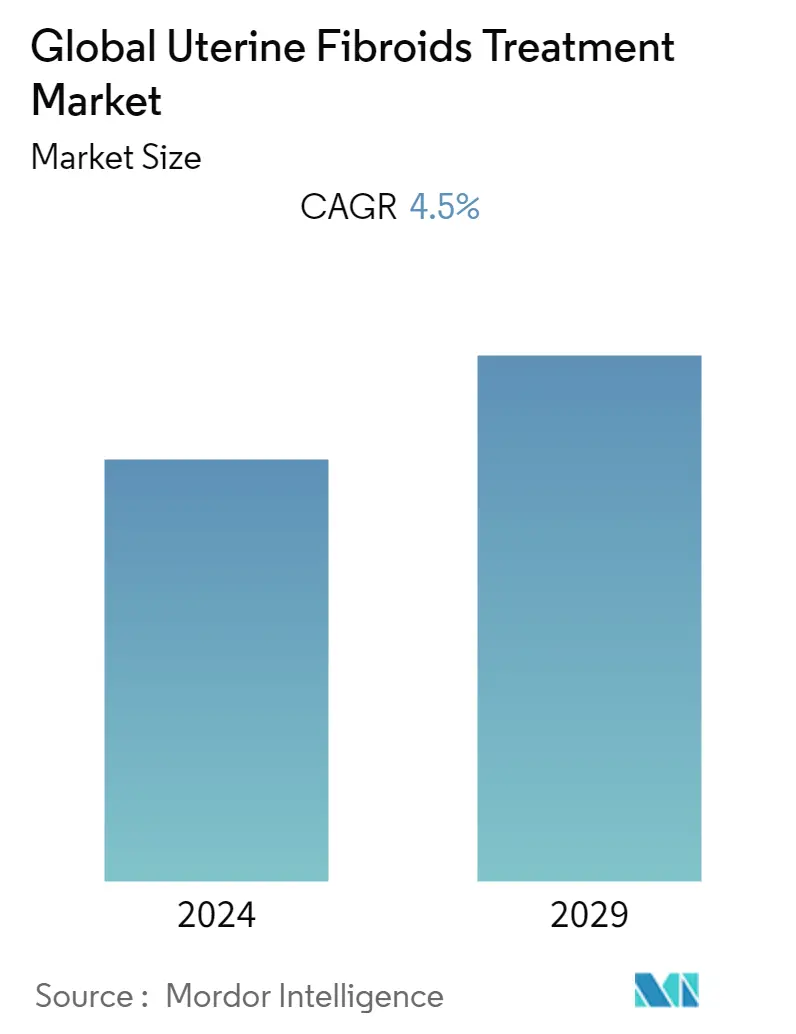Market Size of Global Uterine Fibroids Treatment Industry

| Study Period | 2019 - 2029 |
| Base Year For Estimation | 2023 |
| CAGR | 4.50 % |
| Fastest Growing Market | Asia-Pacific |
| Largest Market | North America |
| Market Concentration | Medium |
Major Players
*Disclaimer: Major Players sorted in no particular order |
Need a report that reflects how COVID-19 has impacted this market and its growth?
Uterine Fibroids Treatment Market Analysis
The Uterine Fibroids Treatment Market is projected to register a CAGR of 4.5% during the forecast period (2022-2027).
The coronavirus pandemic has caused major changes worldwide, especially in healthcare systems. The COVID-19 pandemic resulted in the cancellation of all elective procedures. While patients with uterine fibroids are not at risk in the same way as Critical Limb Ischemia patients are, their quality of life has been adversely impaired in some cases. As a result, restrictions on access to elective therapies, imposed either to decrease virus cross-transmission or to prepare the hospital structure to aid infected patients, have forced women to live with discomfort and ineffective temporary treatments. As a result, restrictions on access to elective therapies, imposed either to decrease virus cross-transmission or to prepare the hospital structure to aid infected patients, have forced women to live with discomfort and ineffective temporary treatments.
The market is likely to be driven by the high prevalence of uterine fibroids among women worldwide, increased patient preference for less invasive procedures, and the adoption of technologically sophisticated technologies. Excessive menstrual flow, pelvic pain, infertility, and frequent urination are all symptoms of uterine fibroid (UF), a benign tumor of the smooth muscle cells that grow in the uterus. Even though the etiology is unknown, race, age, genetic susceptibility, premenopausal status, hypertension, overweight, and diet are all risk factors. Per the article published by Contemporary OB/GYN in February 2022 on "A Look At the Current State of Uterine Fibroid Care," over 70% of women are estimated to develop uterine fibroids by age 50.
Furthermore, the market is predicted to develop due to patients' preference for minimally invasive and non-invasive fibroids operations. Smaller incisions reduce post-operative pain and speed recovery, resulting in the widespread use of these procedures. Several major firms are investing in R&D to bring new minimally invasive and non-invasive surgical devices to market. One of the incision-less techniques physicians commonly suggest is MR-guided Focused Ultrasound (MRgFUS) for treating uterine fibroids. The gadget emits ultrasonic beams, which heat and remove specific tissue from the uterine cavity during this treatment. As this is a non-invasive procedure, there are little to no side effects, and patients can resume normal activities within a few days. As a result of the increased demand for such operations due to their little pain, efficacy, low risk of infection, and quick recovery compared to open surgeries, the market for uterine fibroids treatment devices is expected to rise.
Expanding uterine fibroids awareness and education beyond gynecologic professionals and promoting individualized patient treatment through collaborative decision-making were also flagged as ways to address unmet needs. For example, in November 2021, Minerva Surgical, Inc. (a women's health company specializing in treating AUB) announced the introduction of www.aubandme.com, a new consumer education experience for women. Furthermore, investigating novel non-hormonal medical therapy could lead to advanced fibroids treatment options that do not affect fertility. Upregulation of vitamin D, for example, could protect against fibroid growth while having no harmful influence on ovarian function. Furthermore, Bayer invests in uterine fibroids as part of its clinical development program.
Hence, the availability of advanced products, surgical techniques, and initiatives by various market players contribute to the overall market growth.
